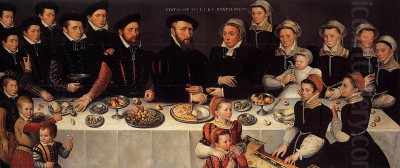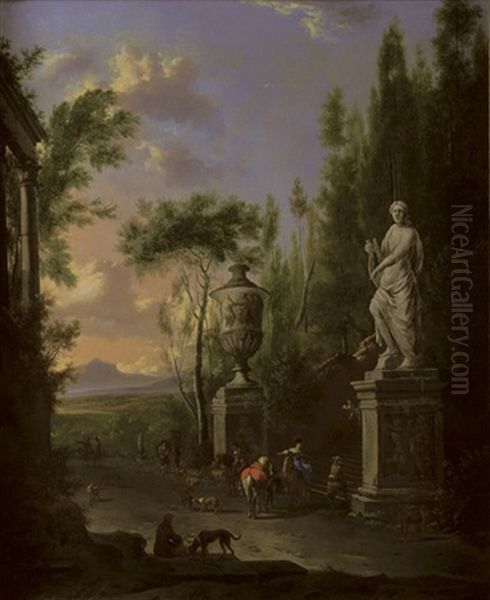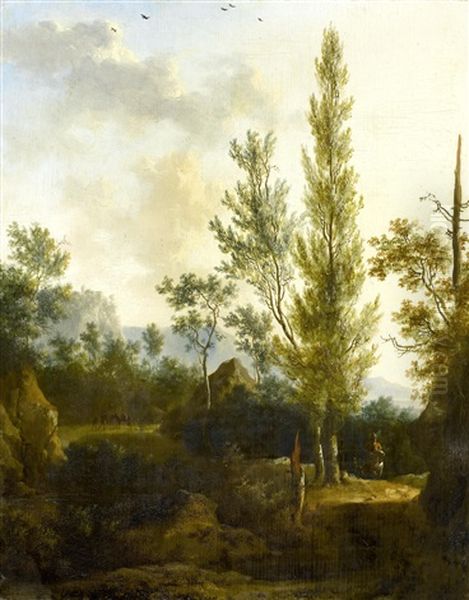Introduction

Frederick de Moucheron stands as a significant figure within the rich tapestry of Dutch Golden Age painting. Born in 1633 and passing away in 1686, he dedicated his artistic career primarily to landscape painting, becoming particularly renowned for his evocative depictions of Italianate scenery. Though Dutch by nationality and active predominantly in Amsterdam, his artistic vision was deeply coloured by the landscapes and classical aesthetics associated with Italy, contributing a distinctively decorative and romantic flavour to the Dutch landscape tradition. His work forms a fascinating bridge between the northern European artistic environment and the enduring allure of the Mediterranean south.
Early Life and Artistic Formation
Frederick de Moucheron was born in Emden in 1633. His family background connected him both to the world of commerce and the arts. His father, Balthazar de Moucheron, was also a painter, and the family, which had French origins, was associated with wealthy wine merchants. His mother was Cornelia van Brouckhoven. This environment likely provided both the means and the encouragement for Frederick to pursue an artistic path from a relatively young age.
His formal artistic training was under the guidance of Jan Asselijn, a prominent Dutch landscape painter himself known for his Italianate style. Asselijn, who had spent time in Italy and was influenced by artists like Claude Lorrain, imparted a style characterized by clarity, bright light, and often incorporating classical ruins or pastoral themes. This tutelage under Asselijn was crucial in shaping Moucheron's own artistic direction, laying the foundation for his lifelong engagement with idealized, sun-drenched landscapes reminiscent of Italy.
Travels and Development
Seeking to broaden his horizons and artistic experience, Frederick de Moucheron travelled to Paris around the age of 22. He spent approximately three years in the French capital, a significant period for absorbing different artistic currents and likely honing his skills. Paris at this time was a major European cultural hub, offering exposure to various artistic trends and patronage opportunities.

Following his stay in Paris, Moucheron's travels continued. Sources indicate he visited Lyon and also spent time in Antwerp, another important artistic centre in the Low Countries. These journeys would have further exposed him to different regional styles and artistic practices. Interestingly, despite his fame for painting Italian landscapes, the provided historical accounts strongly suggest that Frederick de Moucheron never actually travelled to Italy himself. His depictions were thus based on his training, the works of other artists, and perhaps prints and drawings.
By 1659, Moucheron had decided to establish himself permanently. He chose Amsterdam, the vibrant heart of the Dutch Republic and its thriving art market, as his base. He would remain active in Amsterdam for the rest of his life, building a successful career and becoming a recognized master of his chosen genre.
Artistic Style and Characteristics
Frederick de Moucheron's artistic signature is firmly rooted in the Italianate landscape tradition popular among Dutch painters of the era. His works consistently evoke the atmosphere, light, and typical scenery associated with Italy, particularly the Roman Campagna, even without firsthand experience of the location. His style is marked by a distinct preference for idealized, often pastoral or arcadian scenes.
A key characteristic of his work is the skillful manipulation of light and shadow. He often employed a warm, golden light, reminiscent of the Mediterranean sun, bathing his landscapes in a serene and sometimes romantic glow. This careful rendering of light helped create depth and volume, enhancing the three-dimensional quality of his scenes. His colour palette was typically rich yet delicate, contributing to the overall decorative appeal of his paintings.
Moucheron's compositions often feature rolling hills, classical ruins, tranquil bodies of water, and clusters of trees with finely rendered foliage. While nature dominates, human presence is frequently included, often in the form of travellers, shepherds, or hunting parties. These figures, however, are usually subordinate to the grandeur of the landscape itself. His approach combined a degree of naturalistic observation, particularly in the rendering of trees and skies, with a strong element of idealized composition and romantic sentiment. The overall effect is one of harmony, elegance, and a certain picturesque quality.
The Paradox of Italy
One of the most intriguing aspects of Frederick de Moucheron's career is his mastery of the Italianate landscape without having personally visited Italy. This achievement speaks volumes about the artistic environment of the 17th century and the ways artists absorbed influences. His teacher, Jan Asselijn, provided the initial and crucial stylistic foundation, having himself experienced Italy and adopted its landscape aesthetics.

Furthermore, Moucheron would have had access to numerous sources to study the Italian landscape indirectly. Paintings and drawings by artists who had travelled south, including his teacher Asselijn and contemporaries like Nicolaes Berchem or Jan Both, circulated widely in the Netherlands. Prints depicting Italian scenes were also readily available and served as important visual references for artists.
His collaborations with other artists, who often specialized in figures or animals, also played a role. These collaborators might have brought their own experiences or knowledge of Italianate motifs to the joint works. Additionally, the influence of major figures like the French painter Claude Lorrain, whose idealized landscapes were highly influential throughout Europe, permeated the artistic consciousness of the time, providing a powerful model for rendering light and atmosphere in an Italianate vein. Theoretical discussions, possibly influenced by writers like Gérard de Lairesse who emphasized composition and light, may also have informed his approach. Moucheron synthesized these indirect influences into a convincing and personal vision of Italy.
Collaboration in Creation
Collaboration was a common practice in the Dutch art world of the 17th century, and Frederick de Moucheron frequently engaged in it. While he was a master of landscape, he often relied on other specialized artists to populate his scenes with figures and animals (staffage). This practice allowed each artist to focus on their area of expertise, resulting in a high-quality finished product that combined different talents.
Among his most notable collaborators was Adriaen van de Velde, a highly respected painter of figures and animals. Van de Velde's elegant and skillfully painted staffage perfectly complemented Moucheron's landscapes, adding life and narrative interest to scenes, particularly hunting parties or pastoral gatherings. Their joint works are often considered among the highlights of both artists' careers.
Moucheron also worked with Johannes Lingelbach, another artist known for his lively figures often depicted in Italianate settings or harbour scenes. Nicolaes Pieterszoon Berchem, a leading figure among the Dutch Italianate painters himself, also collaborated with Moucheron, bringing his own expertise in figures and animals to Moucheron's landscape settings. Another collaborator mentioned is Dirck Helmbreeker (also referred to as Theodor Helmbreker or Thomas Helberman), who likely contributed figures as well. These collaborations underscore the interconnectedness of the Amsterdam art scene and Moucheron's position within it as a respected landscape specialist whose work provided the perfect backdrop for the contributions of his peers.
Notable Works
Frederick de Moucheron's oeuvre consists primarily of landscapes, often with Italianate themes. Several specific works highlight his style and typical subjects:
One significant example is Italian Landscape with Hunters, dated around 1660 and housed in the Rijksmuseum, Amsterdam. This painting exemplifies his ability to create an idealized Italian setting, likely featuring figures added by a collaborator, within a harmonious composition bathed in warm light.
A later work, Paisaje Fluvial con Cacciatori (River Landscape with Hunters), dated 1685 (100 x 114 cm), showcases his continued engagement with hunting themes set within expansive, atmospheric landscapes. The depiction of the river and surrounding terrain demonstrates his mature landscape technique.
Another piece, A Hawking Party at the Foot of an Ornamental Staircase, with a Mountainous Landscape Beyond, combines aristocratic leisure (a hawking party) with architectural elements (an ornamental staircase) and a dramatic, mountainous backdrop, again characteristic of his idealized, somewhat romantic approach to landscape.
Italian Landscape with Fishers and a Waterfall, also dated 1685 (81 x 71 cm), focuses on a more rugged aspect of the imagined Italian scenery, featuring a waterfall and fishermen. This work likely demonstrates his skill in rendering moving water and varied natural textures, along with his typical attention to light effects.
Beyond easel paintings, Moucheron also undertook decorative projects. Notably, he created large wall paintings for private residences in Amsterdam, such as the three landscape wall panels painted for the house of Adam Otman. Such commissions were relatively rare and indicate the high regard in which his decorative landscape skills were held by wealthy patrons.
Personal Life in Amsterdam
After settling in Amsterdam in 1659, Frederick de Moucheron established not only his professional career but also his family life. In the same year he settled, he married Marieke de Jouderville (also spelled Mariecke). Their union appears to have been fruitful; sources mention they had a large family, with the number of children cited variously as eight, eleven, or twelve, suggesting around eleven or twelve children were born to the couple.
Life in Amsterdam during the Dutch Golden Age offered artists like Moucheron opportunities for patronage and success, but it was also subject to the vicissitudes of life. A significant personal event was the death of his wife, Marieke, in 1671. This loss would undoubtedly have impacted his personal life profoundly, leaving him a widower to raise their children, some of whom would have still been quite young.
Despite this personal loss, Moucheron continued his artistic production. He remained a respected member of the Amsterdam artistic community until his own death. Frederick de Moucheron passed away in Amsterdam in January 1686 and was buried in the Sint Antoenstraten cemetery.
Isaac de Moucheron: The Artistic Heir
The artistic lineage of the Moucheron family did not end with Frederick. His son, Isaac de Moucheron (1667-1744), followed in his father's footsteps and became a notable artist in his own right. Isaac was not only a painter but also an accomplished printmaker and architect, demonstrating a broader range of artistic pursuits than his father.
Isaac initially learned from his father, absorbing the Italianate landscape style that Frederick had mastered. However, unlike his father, Isaac did travel extensively, most importantly spending time in Italy, particularly Rome, between 1695 and 1697. This direct exposure to Italian art and landscape further shaped his style. While in Italy, he was influenced by the classical landscape tradition, particularly the work of French painter Gaspard Dughet, who specialized in heroic landscapes of the Roman Campagna.
Isaac's works often continue the Italianate themes favoured by his father, depicting idealized gardens, classical ruins, and pastoral scenes. Some art historians suggest that Isaac's work, while clearly indebted to his father's style, achieved an even greater level of refinement and perhaps a more spirited execution. He became particularly known for large-scale decorative wall paintings, often featuring elaborate garden scenes or architectural vistas, continuing a practice his father had also engaged in. The careers of father and son demonstrate a continuity of artistic tradition within the family, adapted and evolved by the next generation.
Influences and Connections
Frederick de Moucheron's art was shaped by a network of influences and connections within the European art world. His primary mentor, Jan Asselijn, was pivotal in introducing him to the Italianate style. Asselijn himself was part of a generation of Dutch artists, sometimes called the "Bamboccianti" or Italianates, who travelled south and brought back new approaches to landscape painting.
The pervasive influence of Claude Lorrain, the French master of the idealized landscape based in Rome, cannot be overstated. Though perhaps an indirect influence filtered through artists like Asselijn, Lorrain's revolutionary treatment of light and atmosphere set a standard for landscape painting across Europe, and echoes of his style can be discerned in Moucheron's work, particularly the warm, hazy light.
While Moucheron focused on Italianate scenes, he remained connected to the broader Dutch art scene through his collaborations with figures like Adriaen van de Velde, Johannes Lingelbach, and Nicolaes Berchem. These interactions highlight the collaborative nature of art production and the cross-pollination of ideas in Amsterdam. His work might also be seen in the context of other landscape traditions, though his primary focus remained distinct.
Some sources mention potential reference points like the works of Luca Giordano, an Italian painter, suggesting Moucheron actively studied the works of others to inform his Italianate depictions. The theoretical underpinnings of art, possibly through figures like Gérard de Lairesse who wrote extensively on art theory and practice, might also have played a role in shaping his compositional strategies and aesthetic choices. His son Isaac's later engagement with the styles of Gaspard Dughet and potentially Nicolas Poussin further illustrates the family's connection to the classical landscape tradition. Even his father, Balthazar de Moucheron, being a painter, represents the familial artistic connection.
Legacy and Historical Significance
Frederick de Moucheron carved out a distinct and respected place in the history of Dutch Golden Age art. His primary contribution lies in his popularization and skillful execution of the Italianate landscape style within the Northern Netherlands. While many Dutch artists focused on naturalistic depictions of their local surroundings, Moucheron consistently offered patrons an idealized, sunnier vision inspired by Italy, catering to a taste for the exotic and the classical.
His ability to convincingly evoke Italian landscapes without travelling there is a testament to his skill and the power of artistic transmission through teaching, copying, and collaboration. His works were admired for their decorative qualities, pleasing compositions, and mastery of light, making them desirable additions to the collections of wealthy Dutch burghers. The commissions for large-scale wall paintings further attest to his status and the adaptability of his style to interior decoration.
His influence extended through his students and most notably through his son, Isaac de Moucheron, who carried the family's artistic tradition into the 18th century. Furthermore, the popularity of his work is evidenced by the fact that engravings were made after his paintings, for instance by the engraver Piet Tomkins, which helped disseminate his imagery to a wider audience.
Today, Frederick de Moucheron's paintings are held in major museum collections around the world, including the Rijksmuseum in Amsterdam. They continue to be appreciated for their technical skill, their charmingly idealized vision of Italy, and as important examples of the Dutch Italianate landscape movement. His career reflects the international outlook of Dutch art during its Golden Age and the enduring appeal of the classical landscape tradition.
Conclusion
Frederick de Moucheron remains a noteworthy painter of the Dutch Golden Age, celebrated for his dedication to the Italianate landscape. Through his training with Jan Asselijn, his travels in France and the Low Countries, and his prolific output from his base in Amsterdam, he developed a distinctive style characterized by warm light, harmonious compositions, and a romantic sensibility. His frequent collaborations with figure specialists like Adriaen van de Velde enriched his work, while his ability to evoke Italy without firsthand experience highlights the interconnectedness of the 17th-century art world. His legacy, carried on by his son Isaac and preserved in numerous collections, secures his position as a significant contributor to the diversity and richness of Dutch landscape painting.